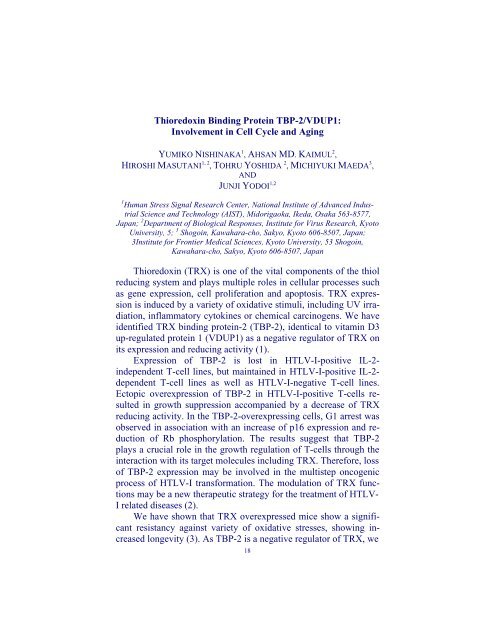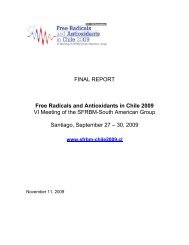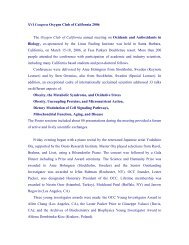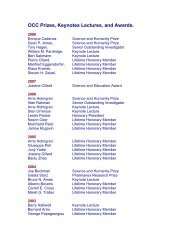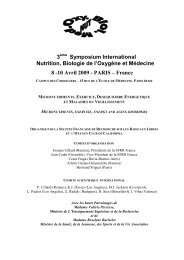oxidants and antioxidants in biology - Oxygen Club of California
oxidants and antioxidants in biology - Oxygen Club of California
oxidants and antioxidants in biology - Oxygen Club of California
Create successful ePaper yourself
Turn your PDF publications into a flip-book with our unique Google optimized e-Paper software.
Thioredox<strong>in</strong> B<strong>in</strong>d<strong>in</strong>g Prote<strong>in</strong> TBP-2/VDUP1:<br />
Involvement <strong>in</strong> Cell Cycle <strong>and</strong> Ag<strong>in</strong>g<br />
YUMIKO NISHINAKA 1 , AHSAN MD. KAIMUL 2 ,<br />
HIROSHI MASUTANI 1, 2 , TOHRU YOSHIDA 2 , MICHIYUKI MAEDA 3 ,<br />
AND<br />
JUNJI YODOI 1,2<br />
1 Human Stress Signal Research Center, National Institute <strong>of</strong> Advanced Industrial<br />
Science <strong>and</strong> Technology (AIST), Midorigaoka, Ikeda, Osaka 563-8577,<br />
Japan; 2 Department <strong>of</strong> Biological Responses, Institute for Virus Research, Kyoto<br />
University, 5; 3 Shogo<strong>in</strong>, Kawahara-cho, Sakyo, Kyoto 606-8507, Japan;<br />
3Institute for Frontier Medical Sciences, Kyoto University, 53 Shogo<strong>in</strong>,<br />
Kawahara-cho, Sakyo, Kyoto 606-8507, Japan<br />
Thioredox<strong>in</strong> (TRX) is one <strong>of</strong> the vital components <strong>of</strong> the thiol<br />
reduc<strong>in</strong>g system <strong>and</strong> plays multiple roles <strong>in</strong> cellular processes such<br />
as gene expression, cell proliferation <strong>and</strong> apoptosis. TRX expression<br />
is <strong>in</strong>duced by a variety <strong>of</strong> oxidative stimuli, <strong>in</strong>clud<strong>in</strong>g UV irradiation,<br />
<strong>in</strong>flammatory cytok<strong>in</strong>es or chemical carc<strong>in</strong>ogens. We have<br />
identified TRX b<strong>in</strong>d<strong>in</strong>g prote<strong>in</strong>-2 (TBP-2), identical to vitam<strong>in</strong> D3<br />
up-regulated prote<strong>in</strong> 1 (VDUP1) as a negative regulator <strong>of</strong> TRX on<br />
its expression <strong>and</strong> reduc<strong>in</strong>g activity (1).<br />
Expression <strong>of</strong> TBP-2 is lost <strong>in</strong> HTLV-I-positive IL-2-<br />
<strong>in</strong>dependent T-cell l<strong>in</strong>es, but ma<strong>in</strong>ta<strong>in</strong>ed <strong>in</strong> HTLV-I-positive IL-2-<br />
dependent T-cell l<strong>in</strong>es as well as HTLV-I-negative T-cell l<strong>in</strong>es.<br />
Ectopic overexpression <strong>of</strong> TBP-2 <strong>in</strong> HTLV-I-positive T-cells resulted<br />
<strong>in</strong> growth suppression accompanied by a decrease <strong>of</strong> TRX<br />
reduc<strong>in</strong>g activity. In the TBP-2-overexpress<strong>in</strong>g cells, G1 arrest was<br />
observed <strong>in</strong> association with an <strong>in</strong>crease <strong>of</strong> p16 expression <strong>and</strong> reduction<br />
<strong>of</strong> Rb phosphorylation. The results suggest that TBP-2<br />
plays a crucial role <strong>in</strong> the growth regulation <strong>of</strong> T-cells through the<br />
<strong>in</strong>teraction with its target molecules <strong>in</strong>clud<strong>in</strong>g TRX. Therefore, loss<br />
<strong>of</strong> TBP-2 expression may be <strong>in</strong>volved <strong>in</strong> the multistep oncogenic<br />
process <strong>of</strong> HTLV-I transformation. The modulation <strong>of</strong> TRX functions<br />
may be a new therapeutic strategy for the treatment <strong>of</strong> HTLV-<br />
I related diseases (2).<br />
We have shown that TRX overexpressed mice show a significant<br />
resistancy aga<strong>in</strong>st variety <strong>of</strong> oxidative stresses, show<strong>in</strong>g <strong>in</strong>creased<br />
longevity (3). As TBP-2 is a negative regulator <strong>of</strong> TRX, we<br />
18


